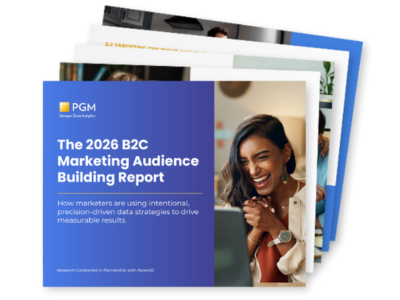What are the biggest data challenges right now, and how are marketers overcoming them? Which data sources are driving the most success? What elements go into successful data strategies?
PGM Solutions partnered with Ascend2 to uncover the answers to these questions in The 2026 B2C Marketing Audience Building Report.
The findings point to clear areas of focus: strategic adaptability to external changes, greater precision in data application, and expanded use of intent-based insights to compound results.
We hope you can put these insights to use in your 2026 marketing efforts to improve performance and stay adaptable.
Key Findings from the 2026 B2C Marketing Audience Building Report
- Managing data across sources still presents issues for B2C marketers. Despite an uptick in data strategy effectiveness (53% now rate their data strategy as very effective at improving performance, vs 46% last year), only about one quarter have successfully centralized and streamlined most of their data sources, while 69% report data unification as a complex pain point.
- Diversification of data types and sources is strongly correlated with better results Top-performing data strategies use a wider range of data types. They are 2.6x more likely than others to report significant use of intent data (51% vs 19%). The best-in-class are also more likely to report significant use of first-party, second-party, third-party, and zero-party data.
- Best-in-class marketers don’t just use more types, they choose sources that can provide real-time, actionable insights. Social media (61% vs 47%), mobile app (47% vs 36%), and CRM data (41% vs 31%) are all used more heavily by top performers to build a precise and current audience view. Third-party demographic, contact, and behavioral/ intent data are also prioritized by top-performing strategies.
- Layering intent data on top of first-party data compounds performance gains. Marketers who use both first-party and intent data extensively report stronger outcomes in personalization (34% vs 22%), customer acquisition (37% vs 28%), and overall customer experience (42% vs 33%), proving that layering drives measurable advantages.
- Clean data lays a foundation. Nearly two-thirds (64%) of B2C companies now use data hygiene tools, up from 56% last year. This number jumps to 75% of top performers using data hygiene tools, compared to just 51% of others. These marketers are also 5x more likely to be very satisfied with their data quality (65% vs 13%), enabling more intentional segmentation and targeting.
How Marketers are Using Data in 2026
6 Data Strategy Insights to Guide Your Targeting
1. 75% of B2C Marketers Report Feeling the Effects of Audience Saturation
The struggle to stand out is real: 75% of B2C marketers report feeling the effects of audience saturation and competition, with 33% saying it’s a constant fight for attention.
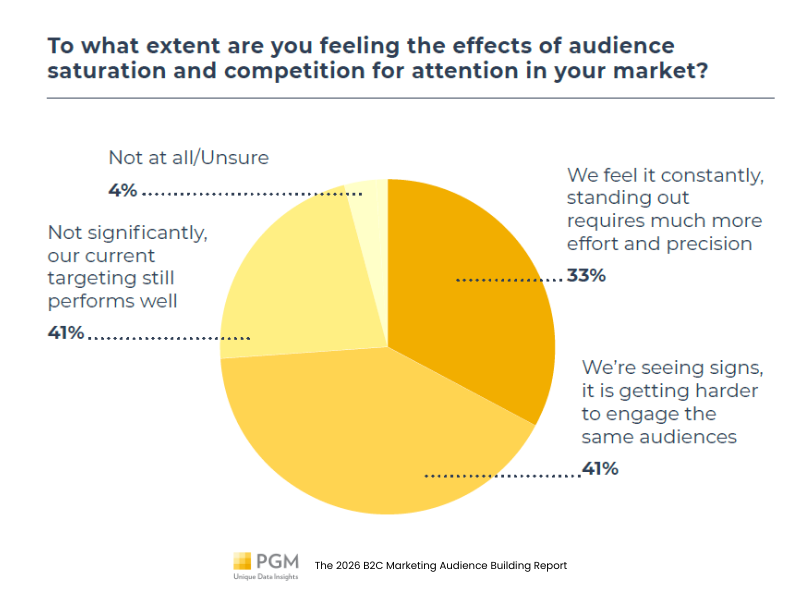
So, how are marketers overcoming audience saturation? The most successful strategies are accelerating a shift toward intentional data use, leveraging real-time behavioral insights and intent signals to anticipate customer needs and tailor engagement precisely.
This proactive approach has led to a major win: 53% of marketers now rate their data strategy as very effective at boosting performance.
2. 81% of Marketers Say that Data Challenges are Holding Them Back
While marketers are becoming more confident, a significant 81% agree that data challenges are holding them back.
Marketers say their biggest challenges are having accurate data for personalization, combining various data sources, and building the right audience segments.
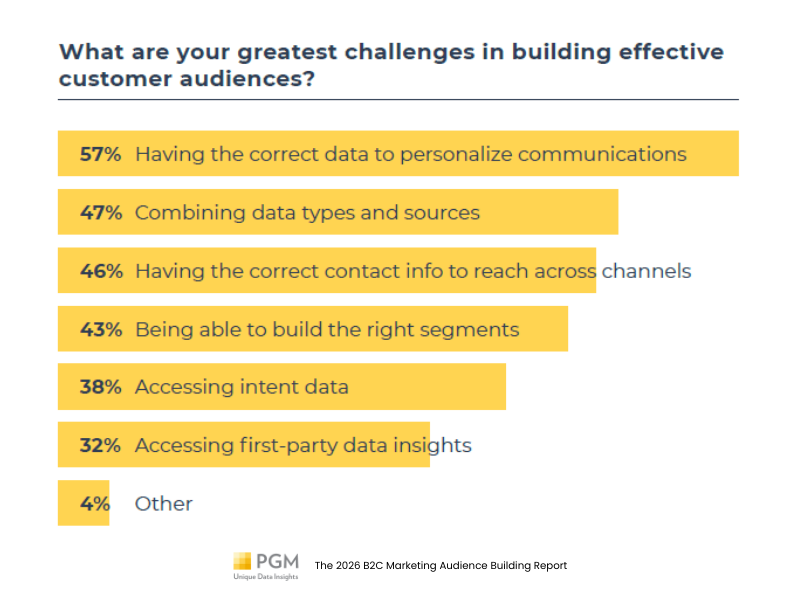
Roughly half of marketers (47%) find layering different data types to be a major obstacle. This is especially true for larger companies, where data complexity is a bigger pain point.
Despite these hurdles, the same elements that cause problems are also the biggest opportunities for success. Accurate data for personalization is considered the most essential element for building effective audiences by 57% of marketers.
In fact, those with the most effective data strategies are putting more emphasis on accessing first-party and intent data, using these insights to improve the timing and relevance of their campaigns.
“Data is powerful, but its true value is offered when it is clean and thoughtfully organized. The biggest challenge isn’t collecting data. It’s making it useful,” says Todd Dziedzic, Head of Data Science.
3. Smart Data Strategies Improve Customer Retention and Brand Awareness
Investing in effective audience building pays off in tangible ways.
The top benefits reported by marketers are improved customer retention (49%) and brand awareness (48%). Other significant advantages include enhanced customer acquisition (46%) and more precise targeting (40%).
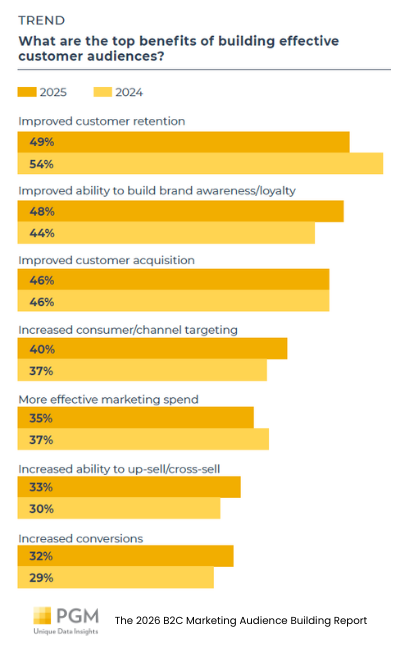
This shows that a strong data strategy isn’t just about efficiency—it’s a direct driver of business growth and customer loyalty.
4. Use of Third-Party Data and Intent Data Are Rising
The data mix is diversifying. While first-party data remains a critical cornerstone (used significantly by 63%), there’s a notable uptick in the use of third-party data (31%) and intent data (36%) compared to last year.
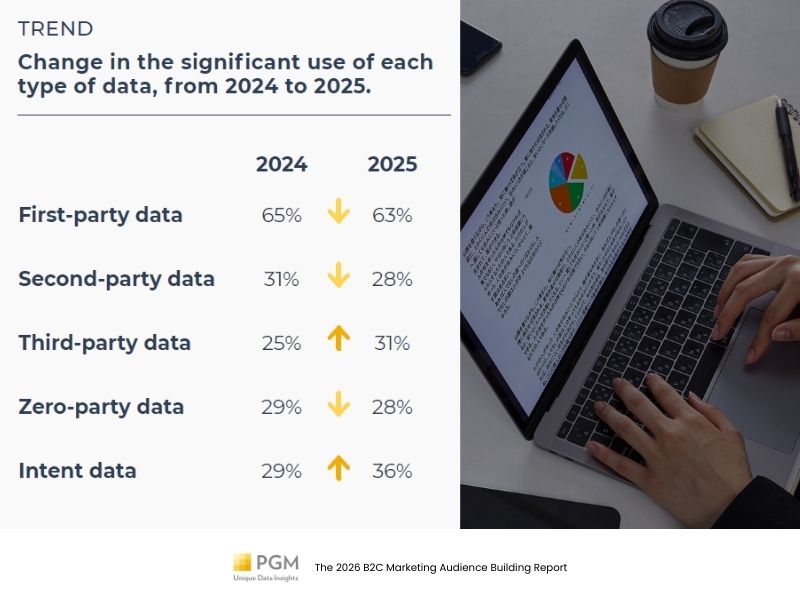
“The findings are clear. Success won’t come from a single data type.. Winners will layer first-party data with high-quality third-party and intent to go beyond basic personalization,” states Michelle Taves, VP & Group GM of Data and Marketing at PGM Solutions.
High-performing “Data Strategy Stars” are 2.6 times more likely to use intent data, demonstrating its power as a success multiplier. The report highlights that layering first-party data with intent data creates a “benefit multiplier,” leading to better personalization, acquisition, and customer experience.
However, the industry’s response to the anticipated deprecation of third-party cookies shows a concerning trend. Many marketers took proactive steps, but nearly half (43%) have since deprioritized these efforts following Google’s delay.
This is a short-sighted move. Those who are most confident in their ability to adapt—the “Pivot Pros”—are the ones who continued to invest in crucial, future-proof actions like expanding first-party data collection and testing new, cookie-less platforms.
5. Improved Segmentation: 45% of marketers now feel they can segment their audience to a “great extent” for personalized messaging
Sophisticated segmentation is on the rise. About 45% of marketers now feel they can segment their audience to a “great extent” for personalized messaging, a significant increase from 35% last year.
While automated segmentation is becoming more common (39%), nearly half of marketers still rely on manual or mixed methods, especially in larger organizations.
The biggest hurdles to effective segmentation remain data accuracy and access. A whopping 40% of marketers cite missing or inaccurate data as a top challenge. This is why data hygiene is now a top priority for 58% of B2C marketers.
The use of data quality software has surged to 64%, and those with the most effective data strategies are using these tools at a much higher rate (75%). They’re also more likely to automate data hygiene practices like deduplication and data validation, showing a clear link between clean data and competitive advantage.
6. AI’s Growing Role in Data Management
As data complexity grows, many marketers are turning to artificial intelligence. Nearly half of B2Cs are now using or exploring AI for data management, primarily for tasks like audience segmentation and personalization.
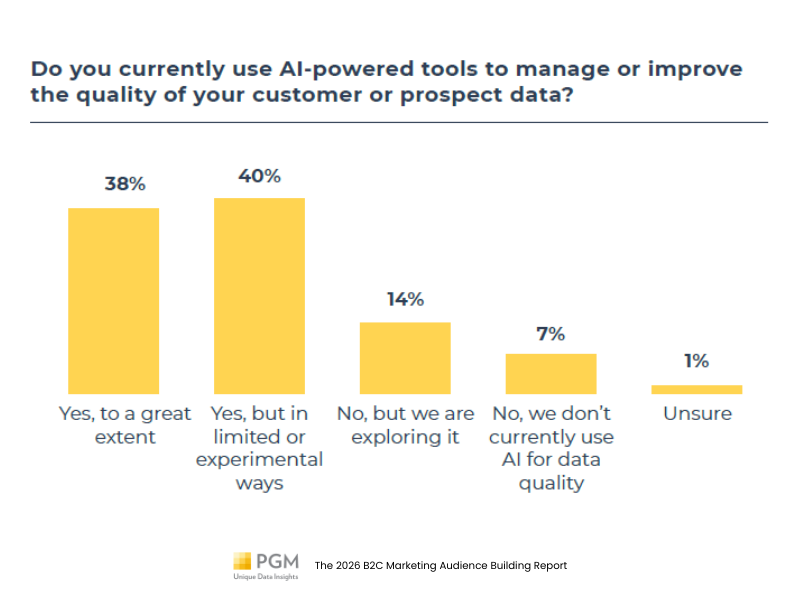
However, concerns about data privacy and the accuracy of AI outputs remain with 59% still having
some reservations when it comes to leveraging AI for audience building. While less than half (43%) report some confidence, another 16% report little-to-no confidence.
Marketers appear to be moving from hesitation to trust, but more time and experience are needed to be fully confident in the accuracy of AI-enhanced data.
For AI to truly become reliable with data management, companies will need to address these concerns and ensure a strategic, intentional approach.
Final Thoughts
In 2026, your success will rely on your ability to leverage data with precision and foresight. Diverse data, strategic planning, and data hygiene are essential elements for building high-performing audiences and driving growth.
Download the 2026 B2C Marketing Audience Building Report for more insights on how marketers are leveraging data to reach consumers across channels.


